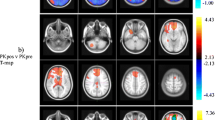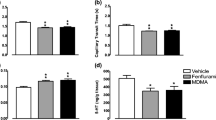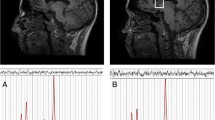Abstract
Rationale
Quantitative neuroimaging studies show that different neuroleptics have similar effects on resting metabolism/perfusion in the basal ganglia, but vary in their effect on the cortex, especially in the prefrontal and temporal lobes. These differences may represent signatures of the action of medication on distinctive receptor combinations.
Objectives
This study seeks to determine the effect on cerebral perfusion at rest of low-dose amisulpride, a neuroleptic with a receptor profile relatively selective to dopaminergic D2-receptors and both antidepressant and antipsychotic efficacy.
Methods
Continuous arterial spin labelling in a placebo-controlled, double blind, crossover study at steady state of N = 20 healthy male adults.
Results
Relative to placebo, amisulpride was associated with extensive and significant cortical decrements in resting perfusion levels, particularly in the prefrontal lobes (p = 0.01, corrected). Decrements spared the basal ganglia, where perfusion was slightly increased.
Conclusions
In contrast to earlier reports on other neuroleptics, amisulpride was associated with intense cortical perfusion decrements at rest. These results are consistent with an existing model in which dopaminergic blockade is associated not only with metabolism/perfusion increases in the basal ganglia, but also with decreases in the cerebral cortex that in most neuroleptics are compensated by action on other receptor systems. The selective receptor profile of amisulpride may explain the extensive cortical decrements.


Similar content being viewed by others
References
Abbas AI, Hedlund PB, Huang XP, Tran TB, Meltzer HY, Roth BL (2009) Amisulpride is a potent 5-HT7 antagonist: Relevance for antidepressant actions in vivo. Psychopharmacol (Berl) 205:119–128
Abler B, Kumpfmüller D, Grön G, Walter M, Stingl J, Seeringer A (2013) Neural correlates of erotic stimulation under different levels of female sexual hormones. PLoS One 8:e54447
Andriamampandry C, Taleb O, Kemmel V, Humbert JP, Aunis D, Maitre M (2007) Cloning and functional characterization of a gamma-hydroxybutyrate receptor identified in the human brain. FASEB J 21:885–895
Bartlett EJ, Brodie JD, Simkowitz P, Dewey SL, Rusinek H, Wolf AP, Fowler JS, Volkow ND, Smith G, Wolkin A, Cancro R (1994) Effects of haloperidol challenge on regional cerebral glucose utilization in normal human subjects. Am J Psychiatry 151:681–686
Bosch OG, Quednov BB, Seifritz E, Wetter TC (2012) Reconsidering GHB: Orphan drug or new model antidepressant? J Psychopharm 26:618–628
Bressan RA, Erlandsson K, Jones HM, Mulligan R, Flanagan RJ, Ell PJ, Pilowsky LS (2003) Is regionally selective D2/D3 dopamine occupancy sufficient for atypical antipsychotic effect? An in vivo quantitative [123I]Epidepride SPET study of amisulpride-treated patients. Am J Psychiatry 160:1413–1420
Bruns A, Künnecke B, Risterucci C, Moreau JL, von Kienlin M (2009) Validation of cerebral blood perfusion imaging as a modality for quantitative pharmacological MRI in rats. Magn Reson Med 61:1451–1458
Carter LP, Koek W, France CP (2009) Behavioural analyses of GHB: Receptor mechanisms. Pharmacol Ther 121:100–114
Chen Y, Wan HI, O’Reardon JP, Wang DJJ, Wang Z, Korczykowski M, Detre JA (2011) Quantification of cerebral blood flow as biomarker of drug effect: Arterial spin labeling phMRI after a single dose of oral citalopram. Clin Pharmacol Ther 89:251–258
Crunelli V, Emri Z, Leresche N (2006) Unravelling the brain targets of γ-hydroxybutyric acid. Curr Opin Pharmacol 6:44–52
Detre JA, Leigh JS, Williams DS, Koretsky AP (1992) Perfusion imaging. Magn Reson Med 3:454–462
Devous MD, Trivedi MH, Rush AJ (2001) Regional cerebral blood flow response to oral amphetamine challenge in healthy volunteers. J Nucl Med 42:535–542
Dunlop BW, Nemeroff CB (2007) The role of dopamine in the pathophysiology of depression. Arch Gen Psychiatry 64:327–337
Farde L, Nordström AL, Wiesel FA, Pauli S, Halldin C, Sedvall G (1992) Positron emission tomographic analysis of central D1 and D2 dopamine receptor occupancy in patients treated with classical neuroleptics and clozapine. Relation to extrapyramidal side effects. Arch Gen Psychiatry 49:538–544
Fernández-Seara MA, Aznárez-Sanado M, Mengual E, Irigoyen J, Heukamp F, Pastor MA (2011) Effects on resting state cerebral blood flow and functional connectivity induced by metoclopramide: A perfusion MRI study in healthy volunteers. Br J Pharmacol 163:1639–1652
Floyd TF, Ratcliffe SJ, Wang J, Resch B, Detre JA (2003) Precision of the CASL-perfusion MRI technique for the measurement of cerebral blood flow in whole brain and vascular territories. J Magn Reson Imaging 18:649–655
Freeman HL (1997) Amisulpride compared with standard neuroleptics in acute exacerbations of schizophrenia: Three efficacy studies. Int Clin Psychopharmacol 12(suppl 2):S11–S17
Gonul AS, Kula M, Sofuoglu S, Tutus A, Esel E (2003) Tc-99 HMPAO SPECT study of regional cerebral blood flow in olanzapine-treated schizophrenic patients. Eur Arch Psychiatry Clin Neurosci 253:29–33
Handley R, Zelaya FO, Reinders AATS, Reis Marques T, Mehta MA, O’Gorman R, Alsop DC, Taylor H, Johnston A, Williams S, McGuire P, Pariante CM, Kapur S, Dazzan P (2013) Acute effects of single-dose aripiprazole and haloperidol on resting cerebral blood flow (rCBF) in the human brain. Hum Br Mapping 34:272–282
Hechler V, Gobaille S, Maitre M (1992) Selective distribution pattern of γ-hydroxybutyrate receptors in the rat forebrain and midbrain as revealed by quantitative autoradiography. Brain Res 572:345–348
Hechler V, Peter P, Goabille S, Bourgouignon JJ, Schmitt M, Ehrhardt JD, Mak J, Maittre M (1993) γ-hydroxybutyrate ligands possess antidopaminergic and neuroleptic-like activities. J Pharmacol Exp Ther 264:1406–1414
Hedlund PB (2009) The 5-HT7 receptor and disorders of the nervous system: An overview. Psychopharmacol (Berl) 206:345–354
Holcomb HH, Cascella NG, Thaker GK, Medoff DR, Dannals RF, Tamminga CA (1996) Functional sites of neuroleptic drug action in the human brain: PET/FDG studies with and without haloperidol. Am J Psychiatry 153:41–49
Holmes AP, Blair RC, Watson JDG, Ford I (1996) Nonparametric analysis of statistic images from functional mapping experiments. J Cereb Blood Flow Metab 16:7–22
Jenkins BG (2012) Pharmacologic magnetic resonance imaging (phMRI): Imaging drug action in the brain. NeuroImage 62:1072–1085
Kapur S, Zipursky R, Jones C, Remington G, Houle S (2000) Relationship between dopamine D2 occupancy, clinical response, and side effects: A double-blind PET study of first-episode schizophrenia. Am J Psychiatry 157:514–520
Kapur S, Zipursky RB, Remington G (1999) Clinical and theoretical implications of 5-HT2 and D2 receptor occupancy of clozapine, risperidone, and olanzapine in schizophrenia. Am J Psychiatry 156:286–293
Kim E, Howes OD, Turkheimer FE, Kim BH, Jeong JM, Kim JW, Lee JS, Jang IJ, Shi SG, Kapur S, Kown JS (2012) The relationship between antipsychotic D2 occupancy and change in frontal metabolism and working memory. Psychopharmacol (Berl) doi:10.1007/s00213-012-2953-0. (epub ahead of print)
la Fougère C, Meisenzahl E, Schmitt G, Stauss J, Frodl T, Tatsch K, Hahn K, Möller HJ, Dresel S (2005) D2 receptor occupancy during high- and low-dose therapy with the atypical antipsychotic amisulpride: A 123I-Iodobenzamide SPECT study. J Nucl Med 46:1028–1033
Lahti AC, Holcomb HH, Weiler MA, Medoff DR, Tamminga CA (2003) Functional effects of antipsychotic drugs: Comparing clozapine with haloperidol. Biol Psychiatry 53:601–608
Lahti AC, Weiler MA, Medoff DR, Tamminga CA, Holcomb HH (2005) Functional effects of single dose first- and second-generation antipsychotic administration in subjects with schizophrenia. Psych Res Neuroimaging 139:19–30
Lange JHM, Reinders JH, Tolboom JTBM, Glennon JC, Coolen HKAC, Kruse CG (2007) Principal component analysis differentiates the receptor binding profiles of three antipsychotic drug candidates from current antipsychotic drugs. J Med Chem 50:5103–5108
Lepoldo M, Lacivita E, Berardi F, Perrone R, Hedlund PB (2011) Serotonin 5-HT7 receptor agents: Structure-activity relationships and potential therapeutic appications in central nervous system disorders. Pharmacol Ther 129:120–148
Maitre M (1997) The γ-hydroxybutyrate signalling system in brain: Organization and functional implications. Progr Neurobiol 51:337–361
Maitre M, Ratomponirina C, Gobaille S, Hodé Y, Hechler V (1994) Displacement of [3H]γ-hydroxybutyrate binding by benzamide neuroleptics and prochlorperazine but not by other antipsychotics. Eur J Pharmacol 256:211–214
Martinot JL, Paillère-Martinot ML, Poirier MF, Dao-Castellana MH, Loc’h C, Mazière B (1996) In vivo characteristics of dopamine D2 receptor occupancy by amisulpride in schizophrenia. Psychopharmacol (Berl) 124:154–158
McKeage K, Plosker GL (2004) Amisulpride: A review of its use in the management of schizophrenia. CNS Drugs 18:933–956
Meltzer HY (1999) The role of serotonin in antipsychotic drug action. Neuropsychopharmacology 21:106S–115S
Meltzer HY, Matsubara S, Lee JC (1989) Classification of typical and atypical antipsychotic drugs on the basis of dopamine D-1, D-2 and serotonin2 Pki values. J Pharmacol Exp Ther 251:238–246
Miller DD, Andreasen NC, O’Leary DS, Watkins GL, Boles Ponto LL, Hichwa RD (2001) Comparison of the effects of risperidone and haloperidol on regional cerebral blood flow in schizophrenia. Biol Psychiatry 49:704–715
Miller DD, Andreasen NC, O’Leary DS, Rezai K, Watkins L, Boles Ponto LL, Hichwa RD (1997a) Effect of antipsychotics on regional cerebral blood flow measured with positron emission tomography. Neuropsychopharmacology 17:230–240
Miller DD, Rezai K, Alliger R, Andreasen NC (1997b) The effect of antipsychotic medication on relative cerebral blood perfusion in schizophrenia: Assessment with Technetium-99 m Hexamethyl-Propyleneamine Oxime single photon emission computer tomography. Biol Psychiatry 41:550–559
Mnie-Filali O, Faure C, Lambás-Senas L, El Mansari M, Belblidia H, Gondard E, Etévant A, Scarna H, Didier A, Berod A, Blier P, Haddjeri N (2011) Pharmacological blockade of 5-HT7 receptors as a putative fast acting antidepressant strategy. Neuropsychopharmacology 36:1275–1288
Montgomery SA (2002) Dopaminergic deficit and the role of amisulpride in the treatment of mood disorders. Int Clin Psychopharmacol 17:S9–S15
Nordin LE, Li TQ, Brogren J, Johansson P, Sjögren N, Hannesdottir K, Björk C, Segerdahl M, Wang DJJ, Julin P (2013) Cortical responses to amphetamine exposure by pCASL MRI and pharmacokinetic/pharmacodynamic dose modeling. NeuroImage 68:75–82
Nordström AL, Farde L, Wiesel FA, Forslund K, Pauli S, Halldin C, Uppfeldt G (1993) Central D2-dopamine receptor occupancy in relation to antipsychotic drug effects: A double-blind PET sutdy of schizophrenic patients. Biol Psychiatry 33:227–235
O’Connor SE, Brown RA (1982) The pharmacology of sulpiride, a dopamine receptor antagonist. Gen Pharmacol 13:185–193
Perrault GH, Depoortere R, Morel E, Sanger DJ, Scatton B (1997) Psychopharmacological profile of amisulpride: An antipsychotic drug with presynaptic D2/D3 dopamine receptor antagonist activity and limbic selectivity. J Pharmacol Exp Ther 280:73–82
Racagni G, Canonico PL, Ravizza L, Pani L, Amore M (2004) Consensus on the use of substituted benzamides in psychiatric patients. Neuropsychobiology 50:134–143
Ramsay SC, Murphy K, Shea SA, Friston KJ, Lammertsma AA, Clark JC, Adams L, Guz A, Frackowiak RSJ (1993) Changes in global cerebral blood flow in humans: Effect on regional cerebral blood flow during a neural activation task. J Physiol (Lond) 471:521–534
Rose SE, Chalk JB, Janke AL, Strudwick MW, Windus LC, Hannah DE, McGrath JJ, Pantelis C, Wood SJ, Mowry BJ (2006) Assessment of dynamic susceptibility contrast cerebral blood flow response to amphetamine challenge: A human pharmacological magnetic resonance imaging study at 1.5 and 4 T. Magn Reson Med 55:9–15
Roth BL, Craigo SC, Choudhary MS, Uluer A, Monsma FJ, Shen Y, Meltzer HY, Sibley DR (1994) Binding of typical and atypical antipsychotic agents to 5-hydroxytryptamine-6 and 5-hydroxytryptamine-7 receptors. J Pharmacol Exp Ther 268:1403–1410
Schoemaker H, Claustre Y, Fage D, Rouquier L, Chrgui K, Curet O, Oblin A, Gonon F, Carter C, Benavides J, Scatton B (1997) Neurochemical characteristics of amisulpride, an atypical dopamine D2/D3 receptor antagonist with both presynaptic and limbic selectivity. J Pharmacol Exp Ther 280:83–97
Shapiro DA, Renock S, Arrington E, Chiodo LA, Liu LX, Sibley DR, Roth BL, Mailman R (2003) Aripiprazole, a novel atypical antipsychotic drug with a unique and robust pharmacology. Neuropsychopharmacology 28:1400–1411
Silva AC, Zhang W, Williams DS, Koretsky AP (1995) Multi-slice MRI of rat brain perfusion during amphetamine stimulation using arterial spin labeling. Magn Reson Med 33:209–214
Smeraldi E (1998) Amisulpride versus fluoxetine in patients with dysthymia or major depression in partial remission: A double blind, comparative study. J Affect Dis 48:47–56
Sparshatt A, Taylor D, Paterl MX, Kapur S (2009) Amisulpride - Dose, plasma concentration, occupancy and response: Implications for therapeutic drug monitoring. Acta Psychiatr Scand 120:416–428
Svensson TH (2003) α-adrenoceptor modulation hypothesis of antipsychotic atypicality. Prog Neuropsychopharmacol Biol Psychiatry 27:1145–1158
Trichard C, Paillère-Martinot ML, Attar-Levy D, Recassens C, Monnet F, Martinot JL (1998) Binding of antipsychotic drugs to cortical 5-HT2A receptors: A PET study of chlorpromazine, clozapine, and amisulpride in schizophrenic patients. Am J Psychiatry 155:505–508
Vernaleken I, Siessmeier T, Buchholz HG, Härtter S, Hiemke C, Stoeter P, Rösch F, Bartenstein P, Gründer G (2004) High striatal occupancy of D2-like dopamine receptors by amisulpride in the brain of patients with schizophrenia. Int J Neuropsychopharmacol 7:421–430
Viviani R (2011) Effects of large-scale nonstationarity on parametric maps. A study of rest perfusion CASL data. NeuroImage 54:2066–2078
Viviani R, Abler B, Seeringer A, Stingl JC (2012) Effect of paroxetine and bupropion on human resting brain perfusion: An arterial spin labelling study. NeuroImage 61:773–779
Viviani R, Beschoner P, Kirchheiner J, Abler B (2009a) Baseline brain perfusion in schizophrenia revisited: An arterial spin labelling study. Pharmacopsychiatry 42:A168
Viviani R, Beschoner P, Lo H, Richter S, Haffer S, Osterfeld N, Thöne J, Sim EJ (2010) Components of acquisition-to-acquisition variance in continuous arterial spin labelling (CASL) imaging. BMC Neurosci 11:30
Viviani R, Sim EJ, Lo H, Richter S, Haffer S, Osterfeld N, Thöne J, Beschoner P (2009b) Components of variance in brain perfusion and the design of studies of individual differences: The baseline study. NeuroImage 46:12–22
Vollenweider FX, Maguire RP, Leenders KL, Mathys K, Angst J (1998) Effects of high amphetamine dose on mood and cerebral glucose metabolism in normal volunteers using positron emission tomography (PET). Psych Res Neuroimaging 83:149–162
Wang DJJ, Chen Y, Fernández-Sara MA, Detre JA (2011) Potential and challenges for arterial spin labelling in pharmacological magnetic resonance imaging. J Pharmacol Exp Ther 337:359–366
Wang JJ, Zhang Y, Wolf RL, Roc AC, Alsop DC, Detre JA (2005) Amplitude-modulated continuous arterial spin-labeling 3.0-T perfusion MR imaging with a single coil: Feasibility study. Radiology 235:218–228
Westerink BHC, Kawahara Y, De Boer P, Geels C, De Vries JB, Wikström HV, Van Kalkeren A, Van Vliet B, Kruse CG, Long SK (2001) Antipsychotic drugs classified by their effects on the release of dopamine and noradrenaline in the prefrontal cortex and striatum. Eur J Pharmacol 412:127–138
Wik G, Wiesel FA, Sjögren I, Blomquist G, Greitz T, Stone-Elander S (1989) Effects of sulpiride and chlorpromazine on regional cerebral glucose metabolism in schizophrenic patients as determined by positron emission tomography. Psychopharmacol (Berl) 97:309–318
Williams DS, Detre JA, Leigh JS, Koretsky AP (1992) Magnetic resonance imaging of perfusion using spin-inversion of arterial water. Proc Natl Acad Sci USA 89:212–216
Wolkin A, Angrist B, Wolf A, Brodie J, Wolkin B, Jaeger J, Cancro R, Rotrosen J (1987) Effects of amphetamine on local cerebral metabolism in normal and schizophrenic subjects as determined by positron emission tomography. Psychopharmacol (Berl) 92:241–426
Acknowledgments
We thank Prof. Jongjong Wang for granting the use of the continuous ASL sequence and Prof. Georg Grön for technical assistance. The authors declare no conflict of interest. This study was conducted without recourse to extramural sources of funding. Experiments complied with the current laws of the Federal Republic of Germany.
Disclosure statement
The authors declare no conflict of interest. This study was conducted without recourse to extramural sources of funding. We have full control of all primary data and we agree to allow the journal to review the data if requested.
Author information
Authors and Affiliations
Corresponding author
Electronic supplementary material
Below is the link to the electronic supplementary material.
ESM 1
(DOC 700 kb)
Rights and permissions
About this article
Cite this article
Viviani, R., Graf, H., Wiegers, M. et al. Effects of amisulpride on human resting cerebral perfusion. Psychopharmacology 229, 95–103 (2013). https://doi.org/10.1007/s00213-013-3091-z
Received:
Accepted:
Published:
Issue Date:
DOI: https://doi.org/10.1007/s00213-013-3091-z




